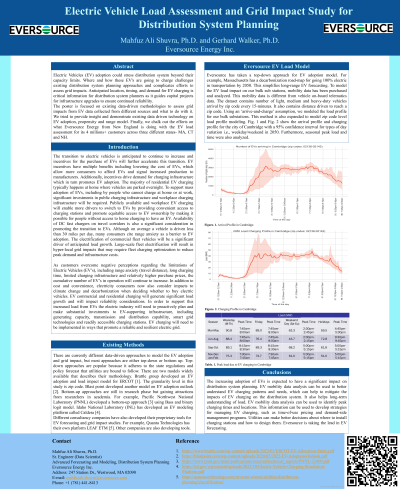Back

RE+ Tech
Electric Vehicle Load Assessment and Grid Impact Study for Distribution System Planning
Tuesday, September 12, 2023
4:30 PM - 5:30 PM PDT
Location: Poster Area, Booth #11024, Level 1, Venetian Expo Hall


Mahfuz A. Shuvra, PhD (he/him/his)
Sr. Engineer (Data Scientist)
Eversource Energy
Westwood, Massachusetts, United States
Poster Presenter(s)
Description and Background: Summary: Electric Vehicles (EV) adoption could stress distribution system beyond their capacity limits. Where and how these EV's are gonna charge challenges existing distribution system planning approaches and complicates efforts to assess grid impacts. Anticipated location, timing, and demand for EV charging is critical information for distribution system planners as it guides capital projects for infrastructure upgrades
to ensure continued reliability. The poster is focused on existing data-driven methodologies to assess grid impacts from EV data collected from different sources and what to do with it. This poster provides insight and demonstrate data driven technology on EV adoption, propensity and range model. Finally, this poster chalks out the efforts on what Eversource Energy from New England is doing with the EV load assessment for its 4 millions+ customers across three different states- MA, CT and NH.
Importance: As customers overcome negative perceptions regarding the limitations of Electric Vehicles (EV’s), including: range anxiety (travel distance), long charging time, limited charging infrastructure and relatively higher purchase prices, the cumulative number of EV’s in operation will continue to increase. In addition to cost and convenience, electricity consumers now also consider impacts to climate change and decarbonization when deciding whether to buy electric vehicles. EV commercial and residential charging will generate significant load growth and will impact reliability considerations. In order to support this increased load from EVs the electric industry will need to proactively plan and make substantial investments to EV-supporting infrastructure, including generating capacity, transmission and distribution capability, smart grid technologies and readily accessible charging stations. EV charging will need to be implemented in ways that promote a reliable and resilient electric grid.
Informative and relevant nature: The transition to electric vehicles is anticipated to continue to increase and incentives for the purchase of EVs will further accelerate this transition. EV incentives have multiple benefits including lowering the cost of EVs, which allow more consumers to afford EVs and signal increased production to manufacturers. Additionally, incentives drive demand for charging infrastructure which in turn promotes EV adoption. The majority of residential EV charging typically happens at home where vehicles are parked overnight. To support mass adoption of EVs, including by people who cannot charge at home or at work, significant investments in public charging infrastructure and workplace charging infrastructure will be required. Publicly available and workplace EV charging will enable more drivers to switch to EVs by providing convenient access to charging stations and also promote equitable access to EV ownership by making it possible for people without access to home charging to have an EV. Availability of DC fast chargers on travel corridors is also a significant consideration in promoting the transition to EVs. Although on average a vehicle is driven less than 30 miles per day, many consumers cite range anxiety as a barrier to EV adoption. However, the median range of a Battery Electric Vehicle (BEV) is increasing. The median range of a BEV was 234 miles in 2021, which represents a 104% increase over the median range of a BEV in 2018. The electrification of commercial fleet vehicles will be a significant driver of anticipated load growth. Large-scale fleet electrification will result in hyper-local grid impacts that may require fleet charging optimization to reduce peak demand and infrastructure costs.
to ensure continued reliability. The poster is focused on existing data-driven methodologies to assess grid impacts from EV data collected from different sources and what to do with it. This poster provides insight and demonstrate data driven technology on EV adoption, propensity and range model. Finally, this poster chalks out the efforts on what Eversource Energy from New England is doing with the EV load assessment for its 4 millions+ customers across three different states- MA, CT and NH.
Importance: As customers overcome negative perceptions regarding the limitations of Electric Vehicles (EV’s), including: range anxiety (travel distance), long charging time, limited charging infrastructure and relatively higher purchase prices, the cumulative number of EV’s in operation will continue to increase. In addition to cost and convenience, electricity consumers now also consider impacts to climate change and decarbonization when deciding whether to buy electric vehicles. EV commercial and residential charging will generate significant load growth and will impact reliability considerations. In order to support this increased load from EVs the electric industry will need to proactively plan and make substantial investments to EV-supporting infrastructure, including generating capacity, transmission and distribution capability, smart grid technologies and readily accessible charging stations. EV charging will need to be implemented in ways that promote a reliable and resilient electric grid.
Informative and relevant nature: The transition to electric vehicles is anticipated to continue to increase and incentives for the purchase of EVs will further accelerate this transition. EV incentives have multiple benefits including lowering the cost of EVs, which allow more consumers to afford EVs and signal increased production to manufacturers. Additionally, incentives drive demand for charging infrastructure which in turn promotes EV adoption. The majority of residential EV charging typically happens at home where vehicles are parked overnight. To support mass adoption of EVs, including by people who cannot charge at home or at work, significant investments in public charging infrastructure and workplace charging infrastructure will be required. Publicly available and workplace EV charging will enable more drivers to switch to EVs by providing convenient access to charging stations and also promote equitable access to EV ownership by making it possible for people without access to home charging to have an EV. Availability of DC fast chargers on travel corridors is also a significant consideration in promoting the transition to EVs. Although on average a vehicle is driven less than 30 miles per day, many consumers cite range anxiety as a barrier to EV adoption. However, the median range of a Battery Electric Vehicle (BEV) is increasing. The median range of a BEV was 234 miles in 2021, which represents a 104% increase over the median range of a BEV in 2018. The electrification of commercial fleet vehicles will be a significant driver of anticipated load growth. Large-scale fleet electrification will result in hyper-local grid impacts that may require fleet charging optimization to reduce peak demand and infrastructure costs.
